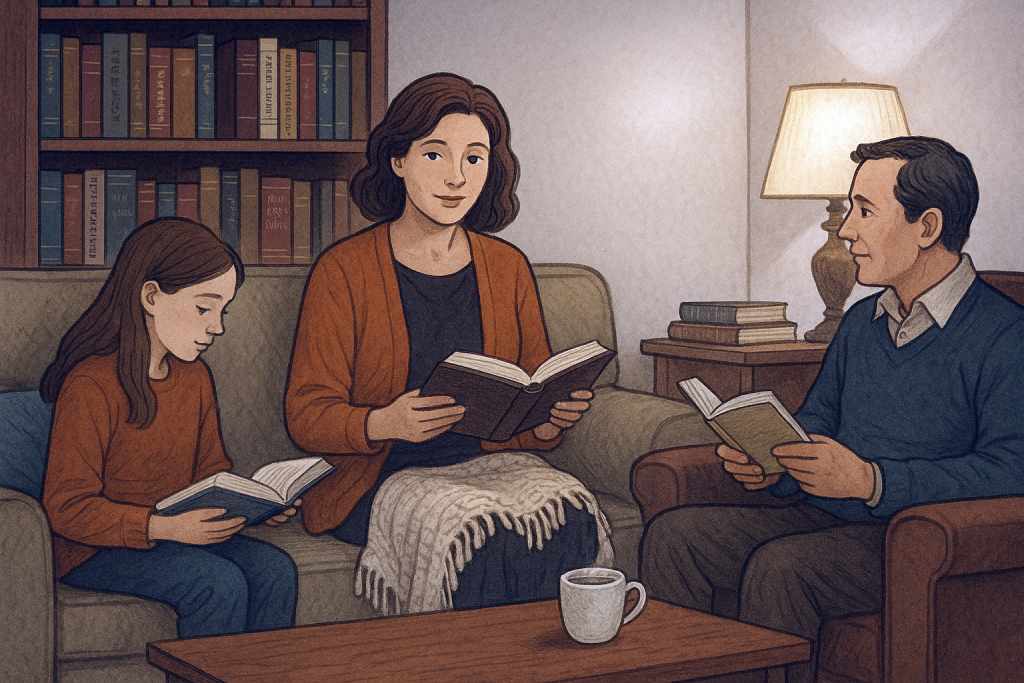Domestic fiction has often been consigned to the margins of literary discourse, dismissed as a minor form preoccupied with familial sentiments or what was once reductively labeled as “women’s writing.” Yet beneath its unassuming surfaces, it constructs a distinct mode of storytelling through which the private sphere is not simply depicted but composed, contested, and critically reimagined.
Far from being limited to household affairs, domestic fiction offers a focused lens through which power, conflict, and identity are negotiated in ordinary settings. It dramatizes the stakes of the everyday, often embedding structural concerns such as gender, class, and kinship within personal relationships.
This article explores what domestic fiction encompasses, its formal and thematic features, and examples of works that push the form beyond its reductive labels.
What is domestic fiction?
At its simplest, domestic fiction refers to literary works that center on home life, familial relationships, and the internal dynamics of everyday living. The term historically emerged during the 19th century, when novels written by and about women that are set largely in domestic spaces were dismissed as sentimental or trivial. The pejorative connotations lingered, yet the genre evolved to encompass much more than tea-table melodrama.
Defining Traits
Domestic fiction is defined not by its setting alone but by the moral, emotional, and political scrutiny it brings to personal life. The genre frequently examines:
- Family structures and tensions
- Gender roles and expectations
- Private vs. public identities
- The politics of caretaking, marriage, and motherhood
- Interiority, unspoken tensions, and emotional burden
These concerns often unfold through subtle narrative developments: a shift in tone, an unresolved conversation, a hidden letter, or the slow erosion of routine. Conflict is rarely grandiose; it brews quietly in the intimate spaces between those bound by familiarity.
Aesthetic Features and Narrative Strategies
Though domestic fiction varies in form and tone, it often avoids sensationalism. It favors a measured narrative pace and a sustained focus on interior life. Many such novels are written in close third person or first person, thereby reinforcing the intimacy of thought and feeling.
- Restraint as form: Domestic fiction often withholds rather than declares. Its drama arises from emotional nuance, withheld speech, or simple acts of rebellion. These narrative choices are not mere stylistic flourishes but constitute the form’s ethical and political grammar.
- The poetics of the mundane: It is in the mundane that domestic fiction locates its energy. The genre focuses attention on routine or domestic labor, treating them as narrative devices instead of background detail. In works such as Marilynne Robinson’s Home (2008), the preparation of meals, the quiet walk to church, or a sibling’s return from exile become sites of profound tension.
Historical Shifts and Critical Reassessments
Though its associations with 19th-century women’s writing remain strong, domestic fiction has undergone significant transformation. Early examples often concluded with marriage, reward, or moral resolution; contemporary works, on the other hand, are more likely to destabilize or examine closely those endings.
- From sentiment to subversion: Susan Warner’s The Wide, Wide World (1850) or Elizabeth Gaskell’s Ruth (1853) typify the 19th-century domestic novel in its moralizing function and emphasis on feminine virtue. By contrast, more recent works treat the domestic as a site of entrapment or reinvention. In Outline (2014) by Rachel Cusk, the narrator’s domestic history is gradually unspooled through the voices of others, leaving the center of the story intentionally vacant.
- Gender, genre, and critique: The genre’s long association with femininity has made it vulnerable to misrecognition. Yet this alignment has also made it fertile ground for feminist and queer reimaginings. Works like Detransition, Baby (2021) by Torrey Peters explore kinship, co-parenting, and non-normative family arrangements with domestic fiction’s focus on intimacy and ambivalence intact.
Notable Works of Domestic Fiction
- Alison Bechdel’s Fun Home (2006): A graphic memoir that explores a daughter’s fraught relationship with her father, Fun Home uses the architecture of their house, its rooms and hidden corners, as a symbolic map of repression, elusive memory, and the distances created by unspoken truths. Domestic space becomes both a repository of personal history and a zone of quiet conflict.
- Kyung-Sook Shin’s Please Look After Mom (2008): Told from multiple perspectives, this novel centers on the disappearance of an aging mother in a Seoul subway station. The family’s retrospective attempts to “find” her unfold into a broader meditation on neglect, memory, and care. Here, domestic fiction becomes a means of reckoning with guilt.
- Sara Baume’s A Line Made by Walking (2017): Isolated in her late grandmother’s house, a young woman documents deteriorating wildlife and contemporary artworks. The novel explores grief, depression, and the minutiae of bodily routines. Home is not a refuge here but a condition to be endured and transformed.
- Amina Cain’s Indelicacy (2020): Sparse, elliptical, and philosophical, this novella follows a cleaning woman in an art museum who marries into wealth but seeks an intellectual life beyond the confines of marriage. The domestic becomes both a setting and a subject of inquiry.
- Jon McGregor’s Even the Dogs (2010): This novel examines domestic breakdown through hollowness, severe neglect, and addiction. It centers on a man found dead in his flat and the visible remnants of his private life. The work uses the intimate setting to confront marginalization, urban poverty, and despair, retaining the genre’s required focus on minute details.
Domestic Fiction and the Question of Scale
To ask what domestic fiction is is to reckon with a form that has been repeatedly underestimated. To uncover its very essence, one would find that it is defined by its unique orientation around a specific kind of attention that is interior to life, to emotional patterning, and to the textures of ordinary existence, instead of being constrained by gender or sentiment.
What makes domestic fiction so frequently misunderstood is its refusal to scale up. Its events are modest, but the emotional, ethical, and existential consequences are anything but. It circumvents grandiosity, not out of caution, but as a formal principle.
Domestic fiction may turn its gaze inward, but its reach extends into the structures that govern intimacy, identity, and power. These works, in their stillness, uncover the quiet urgencies embedded in private life, showing how people endure, accommodate, and come undone within the confines of the familiar. The genre does not declare itself loudly. It continues with steady focus, attentive to the small fissures and subtle shifts that larger narrative forms often pass over.
Further Reading
Domestic Fiction on Encyclopedia.com
Best Domestic Fiction on LibraryThing
Domestic Fiction Books on Goodreads




